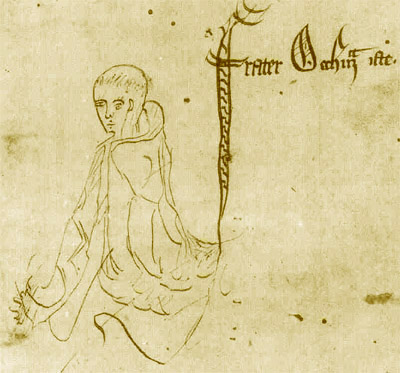End credits song for the project Macaron Cassis Violette, which you can find on this website if you understand some French.
Music: Yoann Le Bars
Puppets and scenery: Chloé Debauges
Artistic direction: Chloé Debauges and Yoann Le Bars
End credits song for the project Macaron Cassis Violette, which you can find on this website if you understand some French.
Music: Yoann Le Bars
Puppets and scenery: Chloé Debauges
Artistic direction: Chloé Debauges and Yoann Le Bars
The Attic is a project I shot in 2007. This is my first short film. Designed somewhat as an exercise, I still wanted to make sure it would interest an audience. Therefore, with a bit of anxiety, I submit it for your consideration. It is French speaking, but I have made subtitles in English (and there are not so many lines):
Karim Debbache’s work is only available in French, but as I have already mentioned him, let me introduce him to you a little further.

The law of parsimony – sometimes called Ockham’s razor after the English Franciscan monk William of Ockham (circa 1285 – 1347), a pioneer in logic – is a principle common to philosophy and science. In fact, it has been stated before, the oldest occurrence that I have found is due to Aristotle1Ἀριστοτέλης, Φυσικὴ ἀκρόασις. Available on-line. An English translation by Robin Waterfield: David Bostock (editor), 1999. Physics, Oxford University Press. Available on-line. (384 – 322 BC), who attributes it to Empedocles (circa 490 – about 435 BC). However, Proclus (412 AD – 485) traces it back to Pythagoras (about 580 – about 495 BC)2The only version I know of the work in question is this German edition, which appears to be considered the reference: Manitius, C. (éditor et translator), 1909. Procli Diadochi hypotyposis astronomicarum positionum (Bibliotheca scriptorum Graecorum et Romanorum Teubneriana), Teubner, Leipzig. Reprinted in 1974: Teubner, Stuttgart..
This principle is not always well understood, as it is sometimes used in a manner denoting a misunderstanding about what it actually means. I propose you to see a brief history of this law before commenting on what it means. This article is therefore one of the series on history of science and popularisation I started with a view from here.
No, I have not yet specified what states this law. This is a barely honest process that aims to create an almost unbearable suspense to make you captive of my prose, so that you will read this whole article. However, do not worry: the explanation comes in a few lines!
Continue reading William had a good razor!
Notes
| ↑1 | Ἀριστοτέλης, Φυσικὴ ἀκρόασις. Available on-line. An English translation by Robin Waterfield: David Bostock (editor), 1999. Physics, Oxford University Press. Available on-line. |
|---|---|
| ↑2 | The only version I know of the work in question is this German edition, which appears to be considered the reference: Manitius, C. (éditor et translator), 1909. Procli Diadochi hypotyposis astronomicarum positionum (Bibliotheca scriptorum Graecorum et Romanorum Teubneriana), Teubner, Leipzig. Reprinted in 1974: Teubner, Stuttgart. |

Jean-Pierre Luminet is the author of the blog e-Luminesciences. But not only: he is also an astrophysicist, cnrs research director at the Laboratoire d’astrophysique de Marseille, as well as at the Laboratoire Univers et théorie. But not only: he also has scientific popularisation and cultural activities. His blog presents all of these activities. This blog has an English version.
Among his notable works, he is a pioneer in black holes realistic representations. As early as 19791Jean-Pierre Luminet, 1979. Image of a Spherical Black Hole with Thin Accretion Disk, Astronomy and Astrophysics, n° 75, pp. 228 – 235. Available on line., he proposed a more realistic and accurate one than the one presented in Interstellar2Christopher Nolan, 2014. Interstellar, Syncopy Films and Lynda Obst Productions.. He also worked on the form – actually, its topology – of the Universe, which led him to introduce the concept of Wraparound Universe3Jean-Pierre Luminet, 2008. The Wraparound Universe, AK Peters Ltd..
Continue reading E-Luminesciences: the blog of Jean-Pierre Luminet
Notes
| ↑1 | Jean-Pierre Luminet, 1979. Image of a Spherical Black Hole with Thin Accretion Disk, Astronomy and Astrophysics, n° 75, pp. 228 – 235. Available on line. |
|---|---|
| ↑2 | Christopher Nolan, 2014. Interstellar, Syncopy Films and Lynda Obst Productions. |
| ↑3 | Jean-Pierre Luminet, 2008. The Wraparound Universe, AK Peters Ltd. |

On July 4, 2012, Atlas and cms experiments of the Large Hadron Collider (lhc) announced that they had identified the beh boson. This led to award 2013 Nobel Prize in Physics to François Englert and Peter Higgs. As I write this, LHC experiments are continuing, while it is rising in energy levels. On August 6, 2014, the space probe Rosetta joined comet 67P/Churyumov-Gerasimenko, dropping a module called Philae on it, among other experiments. This mission is at present still ongoing.
What is the common point between a particle physics experiment and a space science mission? They are both long time experiments: the first articles theorising the beh boson were published in 19641F. Englert and Brout, R., 1964. Broken symmetry and the mass of gauge vector mesons, Physical Review Letters, vol 13, n° 9, pp 321 – 323. doi: 10.1103/PhysRevLett.13.321, available on line. 2P.W. Higgs, 1964. Broken symmetries and the masses of gauge bosons, Physical Review Letters, vol 13, n° 16, pp 508 – 509. doi: 10.1103/PhysRevLett.13.508, available on line. and the design of the lhc began in 1994. Concerning the Rosetta mission, its starting point were in 1984 with the validation of the Horizon 2000 project.
Continue reading Praise the long time
Notes
| ↑1 | F. Englert and Brout, R., 1964. Broken symmetry and the mass of gauge vector mesons, Physical Review Letters, vol 13, n° 9, pp 321 – 323. doi: 10.1103/PhysRevLett.13.321, available on line. |
|---|---|
| ↑2 | P.W. Higgs, 1964. Broken symmetries and the masses of gauge bosons, Physical Review Letters, vol 13, n° 16, pp 508 – 509. doi: 10.1103/PhysRevLett.13.508, available on line. |